
Bruce Nauman is an American artist. His practice spans a broad range of media including sculpture, photography, neon, video, drawing, printmaking, and performance. Nauman lives near Galisteo, New Mexico.

Bill Woodrow is a British sculptor.
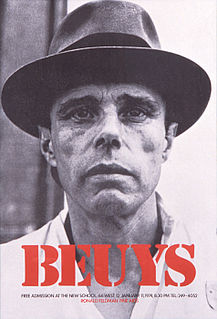
Joseph Beuys was a German artist, teacher, and theorist of art who was highly influential in international contemporary art in the latter half of the 20th century. He is a founder of the art movement known as Fluxus, and a practitioner and exemplar of happenings, and performance art. He adopted media and techniques including paint, sculpture, graphic art, and installation.
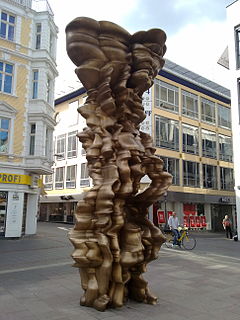
Sir Anthony Douglas Cragg is a British sculptor living in Germany.

Andy Goldsworthy is a British sculptor, photographer and environmentalist who produces site-specific sculptures and land art situated in natural and urban settings. He lives and works in Scotland.
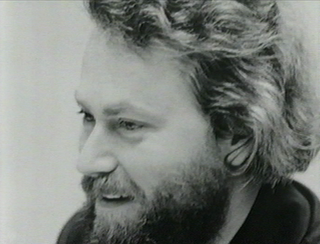
Donald Clarence Judd was an American artist associated with minimalism. In his work, Judd sought autonomy and clarity for the constructed object and the space created by it, ultimately achieving a rigorously democratic presentation without compositional hierarchy. Nevertheless, he is generally considered the leading international exponent of "minimalism," and its most important theoretician through such seminal writings as "Specific Objects" (1964). Judd voices his unorthodox perception of minimalism in Arts Yearbook 8, where he asserts; "The new three dimensional work doesn't constitute a movement, school, or style. The common aspects are too general and too little common to define a movement. The differences are greater than the similarities."

Nek Chand Saini was a self-taught Indian artist, known for building the Rock Garden of Chandigarh, an eighteen-acre sculpture garden in the city of Chandigarh.

Dhruva Mistry is an Indian sculptor.
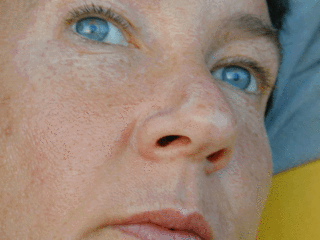
Jane McAdam Freud MA(RCA) FRBS is a British conceptual sculptor working in Installation art and digital media. She was the winner of the 2014 European Trebbia Awards for artistic achievement.
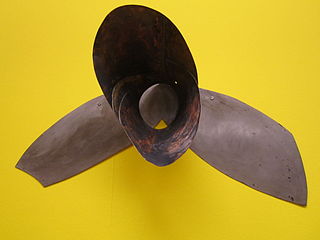
Alison Mary Wilding OBE, RA is an English artist noted for her multimedia abstract sculptures. Wilding's work has been displayed in galleries internationally.

Karla Black is a Scottish sculptor who creates abstract three-dimensional artworks that explore the physicality of materials as a way of understanding and communicating the world around us.

Modern sculpture is generally considered to have begun with the work of Auguste Rodin, who is seen as the progenitor of modern sculpture. While Rodin did not set out to rebel against the past, he created a new way of building his works. He "dissolved the hard outline of contemporary Neo-Greek academicism, and thereby created a vital synthesis of opacity and transparency, volume and void". Along with a few other artists in the late 19th century who experimented with new artistic visions in sculpture like Edgar Degas and Paul Gauguin, Rodin invented a radical new approach in the creation of sculpture. Modern sculpture, along with all modern art, "arose as part of Western society's attempt to come to terms with the urban, industrial and secular society that emerged during the nineteenth century".

Knife Edge Two Piece 1962–65 is an abstract bronze sculpture by Henry Moore. It is one of Moore's earliest sculptures in two pieces, a mode that he started to adopt in 1959. Its form was inspired by the shape of a bone fragment. Moore created the sculpture from an edition of 10 working models in 1962; these working models are now in public collections. Moore created four full-size casts between 1962-1965, with one retained by him. The three casts are on public display on College Green in Westminster, London; Queen Elizabeth Park in Vancouver; and the garden at Kykuit, the house of the Rockefeller family in Tarrytown, New York. Moore's own cast is on display at his former studio and estate, 'Hoglands' in Perry Green, Hertfordshire in southern England. A similar work, Mirror Knife Edge 1977, is displayed at the entrance to I. M. Pei's east wing of the National Gallery of Art in Washington, D.C. The Westminster cast was donated by Moore through the Contemporary Art Society to what he believed was the City of London, but its actual ownership was undetermined for many years. The Westminster cast subsequently fell into disrepair, and was restored in 2013 after it became part of the British Parliamentary Art Collection; it was granted a Grade II* listing in January 2016.
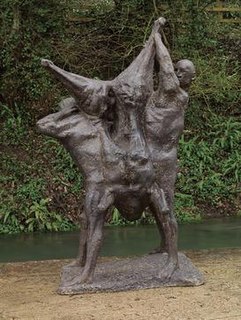
Ralph Brown was an English sculptor who came to national prominence in the late 1950s with his large-scale bronze Meat Porters, commissioned for Harlow New Town, Essex and is known for his sensual, figurative sculptures.
Danny Lane is an American artist, best known for his glass and steel sculpture. Lane is also known for his work in art furniture and contemporary design. He lives and works in London.
Kim Lim (1936–1997) was a Singaporean-British sculptor and printmaker of Chinese descent. She is most recognized for her abstract wooden and stone-carved sculptures that explore the relationship between art and nature, and works on paper that developed alongside her sculptural practice. Lim's attention to the minute details of curve, line and surface made her an exponent of minimalism.

Susanna Heron hon FRIBA is a British site-specific artist recognised for her work in stone relief. Her best known works include Stone Drawing for St John's College, Oxford, completed in 2019, and Henslow's Walk at Sainsbury Laboratory, University of Cambridge, winner of the Stirling Prize 2012.
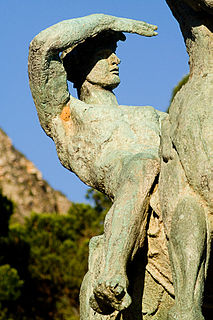
Physical Energy is a bronze equestrian statue by English artist George Frederic Watts. Watts was principally a painter, but also worked on sculptures from the 1870s. Physical Energy was first cast in 1902, two years before his death, and was intended to be Watts's memorial to "unknown worth". Watts said it was a symbol of "that restless physical impulse to seek the still unachieved in the domain of material things". The original plaster maquette is at the Watts Gallery, and there are four full-size bronze casts: one in London, one in Cape Town, one in Harare and one soon to be sited at Watts Gallery - Artists' Village in Compton, Surrey. Other smaller bronze casts were also made after Watts's death.
Christine Hellyar is a New Zealand artist who makes sculptures and installations.

Brian Wall is a British-born American sculptor now living in California. His work consists mainly of abstract welded steel constructions, and his career stretches over six decades. He has had numerous solo shows, and his sculptures reside in many private and museum collections. He was a faculty member at the Central School of Art in London, and a professor of art at the University of California, Berkeley.

















